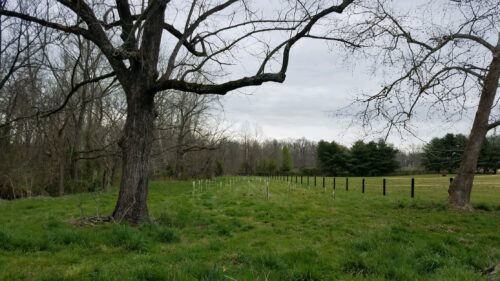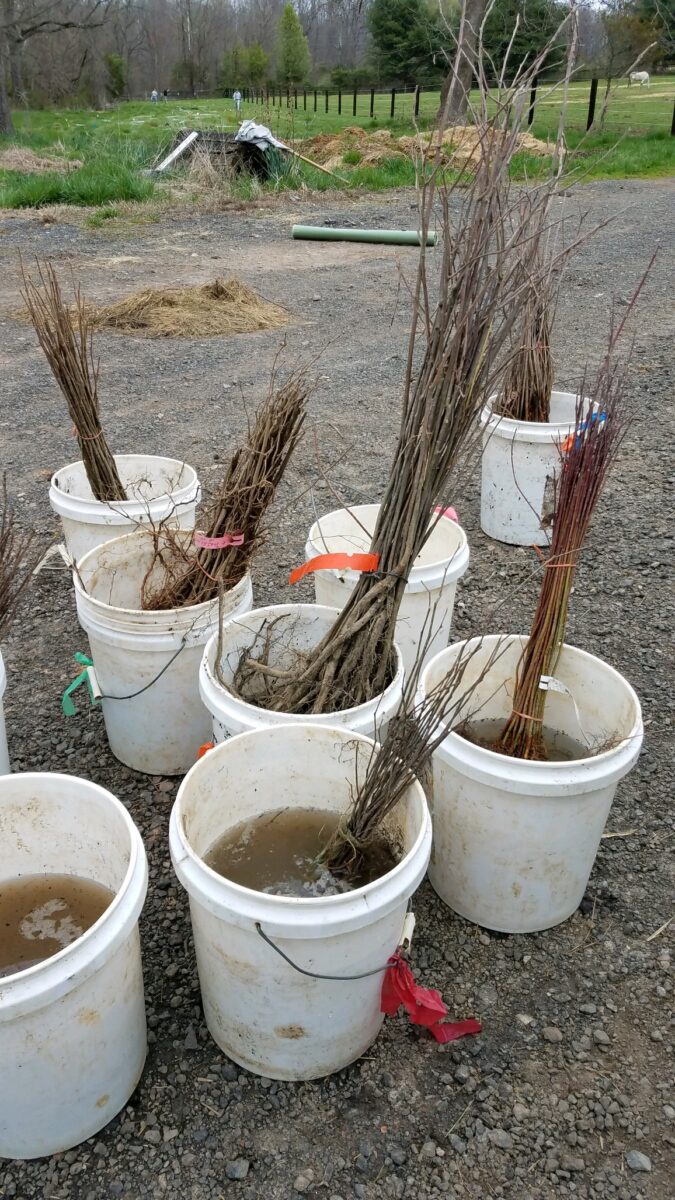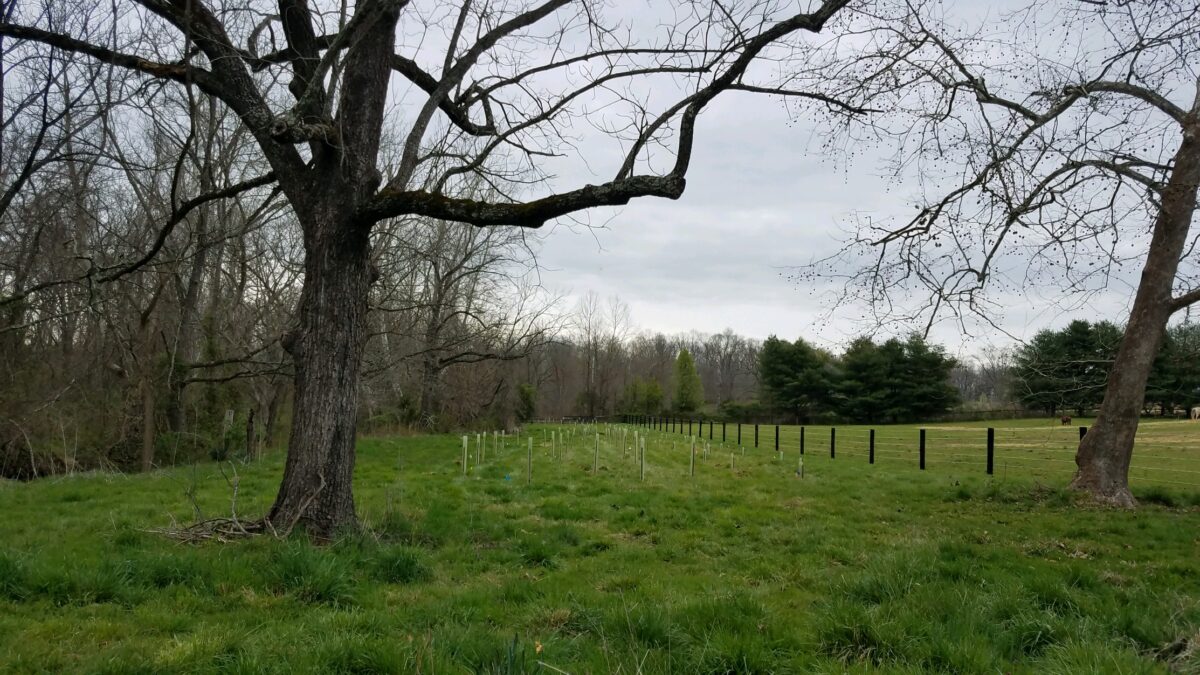Field Notes: In This Together, Apart
June 12, 2020 1:41 pm

by Sarah Parmelee, Area Forester
Despite a spring shrouded in uncertainty, VDOF forester Sarah Parmalee found hope and normalcy in a very simple forestry task – planting trees with her community, together but apart. Tree planting projects were very different during the 2020 spring planting season, but forestry work must continue to keep our forests, waterways and communities healthy and hopeful. Sarah is thankful for the people and organizations that made sure critical tree planting projects, like riparian buffers, were still completed despite the obstacles we’re collectively facing.
I have never appreciated how special tree planting was until this spring. As a forester, you have to like planting trees, it just goes without saying. But in a normal year, you’re rushing to help with a planting after visiting a landowner who needs a plan … hoping that it rained enough that you don’t get a fire when the winds pick up in the afternoon … and knowing that you still have to prepare for an outreach event on the weekend. Tree planting becomes one more thing piled on an already-full plate in spring.
Spring is arguably the busiest and often most stressful time of year for foresters in Virginia; it combines prescribed burning season with wildfire season, planting season and Arbor Day. February through April we are hopping, working odd hours (including weekends) and we’re literally (and figuratively) putting out fires.
This year, nothing was normal due to the COVID-19 crisis. With events cancelled and stay-at-home orders in place, our spring schedules looked different. At first, it was actually nice to miss those pesky meetings we didn’t really want to sit through, but then we started going weeks without seeing our coworkers or being able to meet with forest landowners like we were used to. One of the normal activities that changed dramatically was our riparian buffer planting season.
 Riparian buffers are some of the most important forest in our state. “Riparian” evolved from the Latin word “ripa” meaning streambank, so these are trees planted alongside streams. Unlike the hundreds of acres of pine in Southside Virginia, these narrow forests will likely never be harvested; their value is not in board feet but in the water quality and wildlife habitat they protect and provide. As the riparian buffer trees, grow they will intercept ground pollutants (such as fertilizer and nutrients from manure from adjacent fields or residential areas) before they reach the stream and will use them to grow. They will help to stabilize the soil with their roots – minimizing erosion, absorbing runoff and reducing flooding downstream. In addition, the trees and shrubs planted alongside streams provide habitat for many kinds of wildlife including important pollinator species that rely on native plants for their whole life cycle.
Riparian buffers are some of the most important forest in our state. “Riparian” evolved from the Latin word “ripa” meaning streambank, so these are trees planted alongside streams. Unlike the hundreds of acres of pine in Southside Virginia, these narrow forests will likely never be harvested; their value is not in board feet but in the water quality and wildlife habitat they protect and provide. As the riparian buffer trees, grow they will intercept ground pollutants (such as fertilizer and nutrients from manure from adjacent fields or residential areas) before they reach the stream and will use them to grow. They will help to stabilize the soil with their roots – minimizing erosion, absorbing runoff and reducing flooding downstream. In addition, the trees and shrubs planted alongside streams provide habitat for many kinds of wildlife including important pollinator species that rely on native plants for their whole life cycle.
All these “ecosystem services” provided by forested buffers are incredibly important, not only for Virginia but also, Pennsylvania, Maryland, New York, and West Virginia because we are all part of the Chesapeake Bay Watershed, meaning that the rivers from these states collectively feed into the Bay and have the ability to impact the delicate ecology and economies associated with that incredible body of water.
Most of these plantings in my work areas are organized by Soil and Water Conservation Districts (SWCD) or nonprofit organizations. The actual planting is carried out by staff with the help of volunteers, such as local school kids and Master Naturalists. These planting initiatives provide opportunities to get folks involved in their local watershed and to help get trees in the ground.
However, again, because of COVID-19 this usual approach went out the window in the first few weeks of March and we had to adjust.
Calling off a forest management practice until next year is not uncommon; things come up. However, the tree seedlings for this year’s plantings had already been purchased from the nurseries and were sitting in our tree coolers. They would only sit so long without rotting. These projects couldn’t wait. So, our natural resources community decided to do what we do best; pull together to get stuff done.
In Fauquier County, John Marshall SWCD set up a sign-up sheet to ensure only a small group of folks was at each planting. We traveled separately and stayed out of each other’s space; fortunately, we were planting the trees 10-12 feet apart so it was easy to socially distance. Friends of the Rappahannock (FOR) and Friends of Goose Creek contributed muscle and morale. Thanks to the efforts of these folks, not a single planting in the John Marshall SWCD area was canceled. Additional tree plantings happened in Rappahannock, Culpeper and Madison counties, orchestrated by the go-getters at FOR. Over in Highland County, VDOF forester Clint Folks and the Mountain Valley Work area helped with similar plantings.
I was able to participate with most of the plantings in my work area. It is very different when you’re used to planting with large groups of teenagers who have boundless amounts of energy to burn. An acre feels a lot bigger when you only have six people to scalp, plant and install protective tubes on 300 trees.

But It was arguably some of the most fun that a lot of us had in weeks. The spring was shrouded in uncertainty — every trip to the grocery store was like “Mad Max” meets an episode of “Chopped” and there was no end in sight. Planting season this year was different, but it was special. It meant a lot to the folks involved. It was comforting to see that we could still do our jobs; put trees in the ground, make the world better. Because of the folks who came together to make planting season happen, one day there will be a forest where once there was none.
There is an old saying that “the best time to plant a tree if twenty years ago or today”. Trees are hope for the future. We get our seedlings as little brown sticks and we stick them in the ground and hope that when we come back they will be alive. Some of them will be and some of them will not – that is why we plant more than one. Planting trees is investing the future, whatever future it may be. Whatever happens, the rains will come, roots will grow and leaves will unfurl in the spring.
Thanks for believing in trees. Let’s do it again next year.
Tags: COVID-19, Partnerships, Riparian Forest Buffers, Tree Planting, Volunteer
Category: Urban and Community Forestry
